Winter 2016: Energy Evolution
From carbon dioxide conversion to landfill mining, researchers at UTA are seeking viable alternative energy options.
Skip to content. Skip to main navigation.
From carbon dioxide conversion to landfill mining, researchers at UTA are seeking viable alternative energy options.
Found in everything from space shuttles to dental fillings, composite materials have thoroughly infiltrated modern society. But their potential is still greatly untapped, offering researchers ample opportunity for discovery.
Within the particle showers created at the Large Hadron Collider, answers to some of the universe’s mysteries are waiting.
Model systems like pigeons can help illuminate our own evolutionary and genomic history.
UT Arlington's tiny windmills are bringing renewable energy to a whole new scale.
The stability of our highways, pipelines, and even manholes is reaching a breaking point.
Scientists believe they have discovered a subatomic particle that is crucial to understanding the universe.
UT Arlington researchers unlock clues to the human body’s most mysterious and complex organ.
UT Arlington researchers probe the hidden world of microbes in search of renewable energy sources.
Wounded soldiers are benefiting from Robert Gatchel’s program that combines physical rehabilitation with treatment for post-traumatic stress disorder.
Tiny sensors implanted in the body show promise in combating acid reflux disease, pain and other health problems.
Nanotechnology researchers pursue hybrid silicon chips with life-saving potential.
Biomedical engineers combat diseases with procedures that are painless to patients.
Photographs by Cheryl Power/Science Photo Library/Corbis
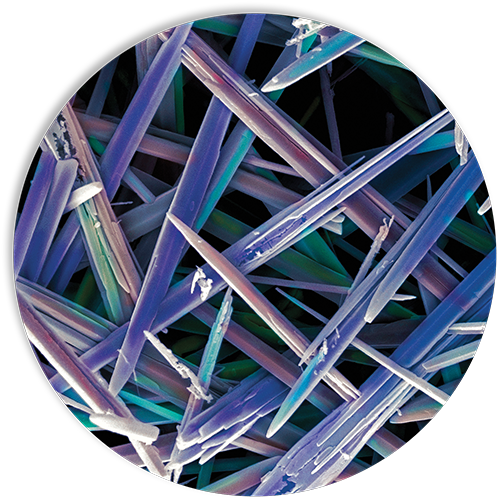

“The whole is greater than the sum of its parts.” This distilled quote comes from Aristotle’s Metaphysics, but the Greek philosopher could just as easily have been referring to composite materials. That’s because a composite, at its most basic level, is the combination of two or more different materials to create a new one that has its own unique benefits.
Take Fiberglas, for example. Widely considered the first modern composite material, its development began in the 1930s, when glass fibers were immersed in a polymer matrix. The resulting material was both strong and lightweight—a contrast to its individual parts, which on their own were brittle (glass fibers) and weak (polymer). Composites made from natural resources have been around for millennia, but today are often defined as a matrix material that binds and is reinforced by a fiber. (Examples of the former are resins, polymers, ceramics, metals such as titanium and copper, and concrete; the latter includes glass, boron, carbon, silicon carbide, and aramid.) They offer a number of advantages over metals and other materials, as composites often weigh less, are stronger and more durable, have a high resistance to corrosion, can be molded into complex shapes, and—perhaps most importantly—have properties that can be tailored to an application’s specific needs.
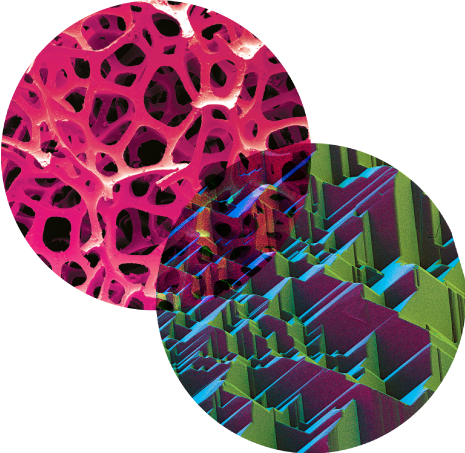
Microscopic images of potential matrices and fibers: (above) synthetic sponge and microdiamond-etched octahedron; (at right) phosphate crystal
Little surprise, then, that composites have thoroughly infiltrated modern society, being found in everything from dental fillings to sports gear to Corvettes to space shuttles. But despite the possibilities the materials offer, there are drawbacks to their further implementation, including high cost, difficulties assessing damage, and gaps in knowledge about their properties and performance.
“When you have a metal, you can melt it, you can solidify it, you can test the properties; it’s one material,” says Mickey McCabe, executive director of The University of Texas at Arlington Research Institute (UTARI). Composites, on the other hand, are combinations of various materials, each with its own properties in play.
“Companies have to select a material based on the performance they want, and then they have to spend money to develop a very detailed database so they know how that material behaves,” Dr. McCabe continues. “It becomes expensive, and that has held back the application of composites. It’s not something that industry can do alone.”
One way to overcome these hurdles is by leveraging the expertise and research capabilities of academic institutions like The University of Texas at Arlington, which can partner with government and industry to address both pressing needs and long-term concerns.
“It’s something that we should exploit and better benefit from,” says Paul Oldroyd, technical fellow at Bell Helicopter Textron. “We’ve had some isolated successes, but we could have had a lot more if we’d been willing to acknowledge the potential opportunities associated with that kind of collaborative effort.
”Oldroyd, who has previously worked with UTA researchers, echoes McCabe about the difficulties companies face developing their own databases for composite materials: They can create them, he says, but haven’t been particularly good at predicting how composites will perform without going through a full testing process.
That’s where universities like UTA come in, as they offer industry an analytical simulation solution as well as methods for predicting the material degradation that results from manufacturing defects. The University’s Advanced Materials and Structures Lab (AMSL), in particular, has been a successful model for such partnerships in rotorcraft applications. Its unique resources and well-recognized theoretical and experimental work include the integration of design and manufacturing processes to improve the performance of composites, advanced materials technologies, material characterization, structural diagnostics, and prognostics.
Photographs by (Bottom Left) Science Photo Library/Corbis; (Top) David Scharf/Corbis; (Left) and Left) Cheryl Power/Science Photo Library/Corbis; (Right) David Scharf/Corbis

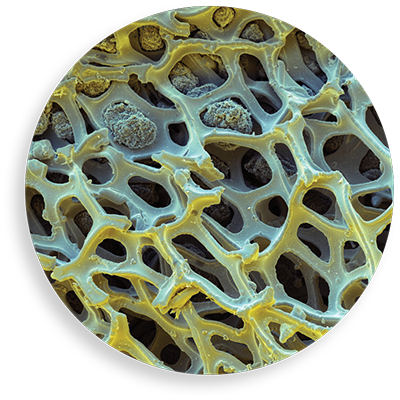
Because a composite is a complex system of materials with multiple tailorable elements and interactions, standard data characterizing its properties doesn’t exist at the outset as it does for metals. How will it perform under certain mechanical or thermal conditions? How long will it last? How will it fail?
Developing databases through testing to answer such essential questions can be incredibly expensive and time-consuming. That’s why The University of Texas at Arlington’s new Institute for Predictive Performance Methodologies is taking a new tack, focusing instead on how these materials can be more quickly designed and used, with reduced cost and risk.
Led by Kenneth Reifsnider, a National Academy of Engineering member who joined UTA in June 2015, the institute aims to develop a fundamental understanding of heterogeneous materials by using a multidisciplinary approach that combines computer modeling with material characterization.

Kenneth Reifsnider
“Predictive analysis is about more than modeling,” Dr. Reifsnider says. “It’s about understanding the pieces and their interactions well enough to know what they’re going to be when we put them together.”
This is a unique capability, and one that has the potential to revolutionize the field, according to UTA Research Institute (UTARI) Executive Director Mickey McCabe.
“When [Reifsnider] is successful doing this on a consistently large scale, he will actually have broken through something that companies have been trying to find the answer to for years,” he says.
One of Reifsnider’s priorities in the short term is to build a diverse research group, which will partially determine the institute’s areas of focus. Its first members include Endel Iarve, an expert in discrete defect modeling, and Rassel Raihan, a faculty associate researcher who serves as lab director.
“We want to build a coherent group of people who share this idea that we can actually make materials in lots of different scales with our knowledge base and our understanding before we pay for extensive testing,” Reifsnider says. “After we have a product, we can find out whether we need to do testing and characterization for validation.”
Based at UTARI, the institute will also feature a substantial laboratory providing new testing capabilities for the region; Reifsnider expects that the first iteration will be completed before this summer. Its manufacturing capabilities will allow researchers to produce small components, while state-of-the-art instrumentation—such as a Novocontrol dielectric spectrometer and a combination mechanical, thermal, and high-rate loading device designed by Reifsnider himself—will yield a broad range of characterization results.
“[Industry] can’t afford to test all of their parts. They’d like to know some answers with smaller components before they make a big chunk of something,” Reifsnider says. “We’ll be able to provide that.”
Photographs by (Top and Bottom Left) Stefan Diller/Science Photo Library/Corbis; (Right) Micro Discovery/Corbis
And that's just the beginning of UTA's contributions to the field. In 2015, the University opened two new centers dedicated to composites research: The Institute for Predictive Performance Methodologies (see sidebar above) focuses on developing a fundamental knowledge base of composite materials, while the Center for Integration of Composites into Infrastructure encourages the growth of composite use in civil engineering.
Various faculty are also doing their own cutting-edge work on the materials. Last year, AMSL Director Andrew Makeev received a $1.35 million grant to continue his work developing diagnostic and predictive tools to assess the performance of composite materials and structures, while Assistant Professor Ashfaq Adnan won a National Science Foundation (NSF) award in support of his visionary project to create less brittle ceramic composites. Associate Professor Luca Maddalena also received a million-dollar Department of Defense grant to build the only university-based, large-scale, arc-heated hypersonic facility in the country to test and study novel heat shields. And Professor Haiying Huang received a Department of Energy grant to develop wireless antenna sensors for real-time monitoring of coal-fired boilers for increased safety and effciency.
In addition to directly supporting industry’s needs, these research projects provide another benefit: They equip today’s students with the tools they need to be tomorrow’s pioneers in the field. Both the University’s location in the Dallas-Fort Worth Metroplex—home to more than 20 Fortune 500 companies—and the opportunities available on campus for students to work on relevant research play a role in preparing graduates to hit the ground running when they join the workforce.
As Erian Armanios, chair of the Department of Mechanical and Aerospace Engineering, says, “My purpose is to make sure that our students, by the time they graduate, meet not only their own needs, but are also grabbed by industry because they already have that unique expertise.”
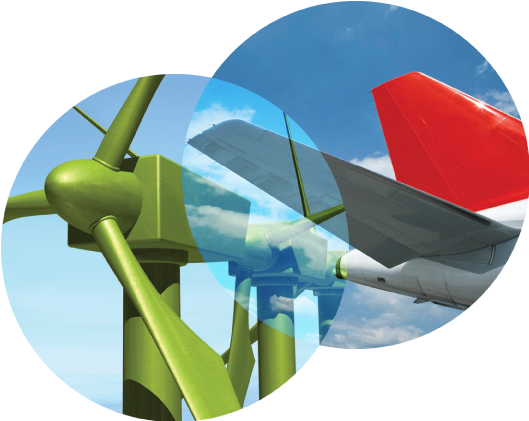
Wind turbines and airplane wings are among the many products being improved through composite materials research
A space vehicle will experience extreme temperatures during its lifespan—the heat shield for the NASA rover Curiosity, for example, had to protect the device from a peak of about 3,800 degrees Fahrenheit during its landing on Mars in 2012. But determining a material’s melting point isn’t enough to gauge its performance in a thermal protection system. That’s also dependent on how atmospheric gases act on the materials and how the materials then react to the friction created.
However, testing such aerothermodynamics is very expensive, and no single ground-testing facility can replicate every factor present in flight. Correlating the results can also be difficult, making it hard to pinpoint a sole contributing factor.
According to mechanical and aerospace engineering Associate Professor Luca Maddalena, these are well-known issues and contribute to a typical development time of 10 years for new thermal protection system materials. A more integrated approach between materials scientists and aerospace engineers is needed to better hone experiments and interpret their results.
To that end, last September the Department of Defense awarded Dr. Maddalena $1.01 million to significantly overhaul the hypersonic wind tunnel housed at UTA’s Aerodynamics Research Center, one of five different large-scale wind tunnels in the facility. When the project is complete, the new tunnel will be the only university-based, large-scale, arc-heated hypersonic-testing facility for thermal protection systems in the country.
“We are trying to expand it to the level where we can capture a much bigger range of relevant hypersonic cruise vehicle trajectories and planetary entry and re-entry conditions,” Maddalena says.
The funds came from the Defense University Research Instrumentation Program through a highly competitive process where the average award was $300,000. UTA has also contributed $210,000 to the project.
Maddalena and his team, which includes post-doctoral fellow Stefano Gulli and master’s student David Campbell, will spend two years designing and constructing the new hypersonic wind tunnel. When complete in summer 2017, it will allow researchers to test the next generation of thermal protection systems, which could be used in projects ranging from national security to space travel. It will also give them the unique ability to perform very basic studies on the material-environment interface in representative conditions.
Researchers at work on rotorcraft applications in the Advanced Materials and Structures Lab
Due to the way a composite part is made—essentially, stacked layers of material are compressed and cured—irregularities such as voids and wrinkles can be introduced into the material during manufacturing. Because these defects may affect the performance and lifespan of the part being produced, they need to be accurately assessed. The irregularities are generally not visible, so knowing what’s happening below the surface early in the design process can ultimately lead to the development of stronger, more durable, and more cost-effec-tive composites and structures.
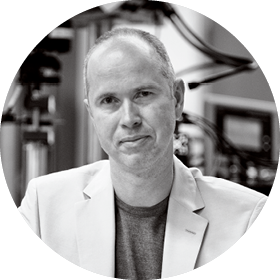
Andrew Makeev
To address this problem, the National Rotorcraft Technology Center (NRTC) awarded mechanical and aerospace engineering Professor Andrew Makeev a grant worth $1.35 million. He will collaborate with Sikorsky Aircraft Corporation on the project.
The key to Dr. Makeev’s innovative method is its integrated approach. First, high-resolution, tomography-based subsurface measurement and structural diagnostics enable an accurate 3-D assessment of a defect’s location and size with an automated transition to structural models. (The latter ensures objectivity and provides consistent results.) Second, accurate and cost-effec-tive methods based on digital image correlation capture the properties of the composite material in 3-D using the minimum amount of mechanical testing. Finally, the physical observations and material properties are combined in a computational analysis to capture multiple damage modes and their interactions to predict lifetime performance.
Later this year, Makeev and his team will also explore a fourth element—predicting where the manufacturing irregularities will actually occur. This could allow the industry to control for such defects in the manufacturing process.
“Developing simulation tools that predict manufacturing-related defects and integrating them with our existing tools for diagnostics and prediction will be essential for closing the loop on effective control of the manufacturing process,” Makeev explains. “This will prevent formation of the critical defects and realize the full potential of composites.”
One of the goals under the new NRTC grant is to prove that the methods developed at AMSL for assessing the mechanical properties of composites can work for any material. This would help increase the rotorcraft industry’s confidence in the designs generated by such methods and shorten the process of qualifying new materials.

Ashfaq Adnan
“The idea is to really increase our confidence in the allowables, in those material properties that go into the structural design,” Makeev says. “Things like how the parts are sized and designed, how strength and durability are determined.”
Because complex deformation and failure mechanisms may not be accurately captured by the current material allowables, they could be overly conservative. Overly conservative design adds excess weight to a structure, limiting its capabilities.
The NRTC grant also serves as a follow-up to the Vertical Lift Consortium’s Advanced Materials Technology Program, which was charged with identifying ways of improving the structural performance of advanced composites in rotorcraft use. That multi-year, collaborative project—which includes members from UTA, Sikorsky, Bell Helicopter Textron, Boeing Rotorcraft Systems, Penn State, and Patz Materials and Technologies (PMT)—showed that adding nanosilica particles with a 100-nanometer diameter into the polymer matrix improved compression strength performance and interlaminar material properties, including fatigue characteristics.
Makeev will continue working on polymeric composites with Sikorsky and PMT, looking at whether these new materials can be implemented in rotorcraft and what further improvement is required.


Maintaining and modernizing infrastructure presents a challenge to governments the world over, as the costs can be staggering. For example, the Federal Highway Administration in 2010 estimated that maintaining our highway system in its current state would cost $101 billion a year for the next 20 years, while improvement investments would bring that number up to $170 billion annually.
Infrastructure deterioration results from a number of causes, including environmental factors such as extreme weather and challenging soil conditions. But poor design and the use of less-than-optimal materials also play a role. While composite materials show promise, they haven’t been widely adopted in civil engineering applications, despite the seeming demand.
One of the main reasons is the lack of standards and codes, although Anand Puppala, Distinguished Teaching Professor and associate dean for research in the College of Engineering, also cites a reluctance in some parts of the community to adopt new materials when current ones are adequate.
To begin changing those minds, The University of Texas at Arlington launched the Center for Integration of Composites into Infrastructure (CICI) in April 2015. Dr. Puppala serves as director, with other members including co-principal investigator Shih-Ho Chao, UTA President Vistasp M. Karbhari, Associate Professor Laureano Hoyos, Assistant Professor Xinbao Yu, and Vice Provost for Academic Planning and Policy Pranesh Aswath.


CICI is initially focusing on three geotechnical projects: the use of lightweight geofoam to reduce the settlement of bridge embankments, led by postdoctoral student Tejo Bheemasetti; geocell use in road pavement subgrades; and the creation of a new, stronger biopolymer as a more natural way of stabilizing road slopes, led by Research Associate Aravind Pedarla. For each, researchers also will attempt to develop codes and standards for the materials, which could hasten their implementation.
UTA’s new center is also addressing sustainability by comparing the costs, environmental effects, and performances of composite materials to traditional methods. So far, they’ve found that using composites is generally more environmentally friendly—the materials last longer and require less transport, installation time, and maintenance.
“Sustainability is highly important. Although building structures with composites may be more expensive, the hope is that the extra initial cost will be recouped through lower maintenance expenses during operational years,” Puppala says. “Our goal is that research conducted by CICI over the next three years will lead to better structures that require less maintenance.”
CICI joins a previously established group led by West Virginia University and funded through the NSF’s Industry/University Cooperative Research Center program. The $1.05 million, five-year grant is expressly intended to foster partnerships between industry, government, and universities.
The group—which also includes North Carolina State University, the University of Miami, and Nanjing Tech University in China—works closely with an industrial advisory board that meets twice a year to decide on the most relevant and pressing topics. Members for the UTA site include the Tarrant Regional Water District, the City of Arlington, ThermaFoam, Measurand, and PSI, with more expected to join later this year.
Photographs by (Top and Left) Cheryl Power/Science Photo Library/Corbis; (Right) hoto Quest Ltd/Science Photo Library/Corbis
Concrete is an ancient and popular construction material used in bridges, dams, roadways, and buildings, but it has one fundamental weakness—cracking.
“That’s the nature of concrete: It’s very weak in tension,” says civil engineering Associate Professor Shih-Ho Chao. “When it cracks, it becomes brittle. It cracks suddenly, and then it’s gone very quickly. So it can be dangerous, especially for structures.”
Although modern concrete is reinforced with steel bars, typical rebar—by virtue of its size—can only reinforce certain areas of a structure. It can also corrode. Dr. Chao’s solution is to replace rebar with small, needle-like steel fibers in the concrete mix. His project is one of the research topics supported by CICI (see sidebar above).
“When the concrete starts to crack, the steel fibers stop the cracks because they’re holding the shape, preventing them from opening up,” he says. “This totally changes the property of concrete, so it becomes much tougher; it won’t crack easily.”
The resulting fiber-reinforced concrete is six times stronger than conventional concrete. Ultimately, a structure made from this next-generation material will last longer and require less frequent repair, making it both a more cost-effective and sustainable solution over the long term.
Attractive properties such as strength, hardness, durability, and resistance to corrosion have made ceramics a popular choice for a wide variety of applications, from kitchen knives and car brake pads to hip replacements and microprocessors. But it’s their high heat tolerance—some ceramics have a melting point of over 3,000 degrees Celsius—that makes them truly unique.
“No material can sustain that high of a temperature except ceramics,” says Ashfaq Adnan, assistant professor in the Mechanical and Aerospace Engineering Department. “There are certain applications where ceramics are the only material that can do the job.”
At the same time, the strong ionic and covalent bonds that give ceramics these attributes also make them brittle. In space vehicles, ceramics play an essential role in thermal protection systems, but they’re not a perfect fit for the job. A grim example of this was seen in 2003, when a piece of foam insulation broke off the space shuttle Columbia during liftoff and cracked some of the carbon-carbon (C/C) ceramic tiles on the wing, creating a breach that led to the shuttle’s disintegration upon its re-entry to Earth.
“I am looking for a way to build a ceramic material that can deform more like a ductile material, so that its so-called toughness can be increased without losing the good properties that it already has,” Dr. Adnan explains.
To do this, he is blending two ceramics with different crystal sizes but similar, thermodynamically compatible structures by manipulating the materials at the molecular level.
Adnan describes ceramics as “stubborn,” in the sense that their atoms have a fixed angle of connection from which they’re generally unwilling to deviate. This is what makes them break more easily than, say, metal, which has a less rigid structure. However, if an atom from one ceramic is placed next to an atom from a similar ceramic, the two may be willing to shift a little and bond.
“We believe that kind of shifting at the very nanoscale will—when we apply mechanical force—enable ceramics to deform more than they typically do when they don’t have this neighbor present,” he says. The hope is that the small, individual shifts can be applied across the material, adding up to a big effect.
This research won Adnan and his co-principal investigator, William Fahrenholtz from the Missouri University of Science and Technology, an 18-month NSF Early-Concept Grant for Exploratory Research. Such awards are intended for visionary projects that, if successful, could have great impacts on their fields.
Adnan has computationally manufactured and tested his new ceramics; his colleagues in Missouri are handling the experiments. He says they’re working to answer two main questions: Can an idea generated from atomistic simulation results be applied to actually manufacture a ceramic in a lab? And if so, does the manufactured ceramic behave the way the computer model indicates?
The team will primarily use hafnium diboride, zirconium diboride, and zirconium carbide as their materials systems.
“This is a group of materials that is used in high temperatures for extreme conditions, and brittleness is one of the bottlenecks preventing very widespread application,” Adnan explains. If his team can find a solution, the stronger ceramics could eventually be found in highly efficient power plants and high-temperature gas sensors, in addition to thermal protection systems for hypersonic and re-entry vehicles.